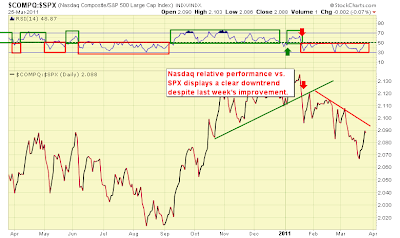NOTE: The Market Tour Blog will return on April 11th.
The S&P500 gained 2.7% last week as the index rose through two key moving average indicators, albeit on weak volume. Although this unconvincing bounce helped to sustain the uptrend from August, we would rather see a close above 1330 (16 points away from Friday's close) to safely call this a short-lived correction in a sustained uptrend.
The Nasdaq saw a stronger recovery vs. the S&P500 last week, rising over 3.7%, but had suffered a higher loss during the early March weakness. This index continues to sport obvious underperformance vs. the S&P500:
VIX saw a significant decline last week. As noted in the chart below, VIX fell from over 29 and closed just below 18 and below its 50-day moving average near 20. The index at 29 represented a huge gap from its 50-day moving average of 19 (such large gaps tend to mark turning points in equities), which coincided with the correction's bottom during the week of March 14 (foreshadowing the bounce last week). VIX is now at a neutral reading (neither bullish nor bearish), and the Put/Call ratio at .84 is likewise neutral. See the VIX chart below:
Our "NYMO" indicator, the McClellan Oscillator advance/decline measure of the New York Stock Exchange, flashed a positive sign last week. The indicator closed above its 13 and 34-day moving averages, and importantly, its cumulative summation index returned to bull market territory (closing over the 400 level):
As for other indicators, most saw improvement on the week. Our corporate debt/medium-term Treasury ratio turned around to positive territory last week, tipping the scales in favor of equities. Small Cap stocks continue to beat large caps, and growth continues to shine vs. value. Discretionary stocks performed better than Staples on the week, another positive.
What had originally looked like an oversold bounce is getting closer to transforming itself into a resumption of the strong uptrend and another possible bout with the recent highs. Volume however has been weak, and quality stocks are not showing the eager bullishness that one would expect in this uptrend. The uptrend is tiring, and positive seasonal conditions may be giving it enough juice to continue higher in a rather haphazard way.
Click here for the updated Market Tour on StockCharts.com.
Chart Pattern Indicator: What's the Reading?
1 week ago














